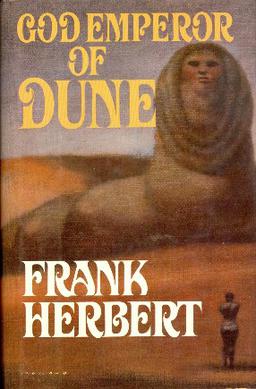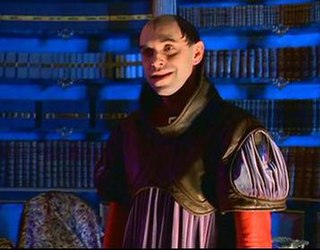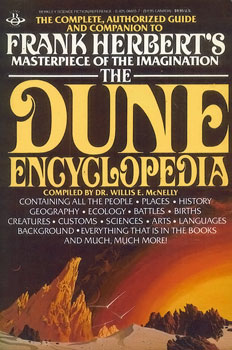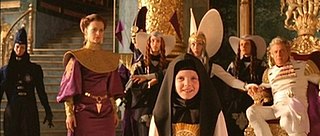
Children of Dune is a 1976 science fiction novel by Frank Herbert, the third in his Dune series of six novels. Originally serialized in Analog Science Fiction and Fact in 1976, it was the last Dune novel to be serialized before book publication.

Chapterhouse: Dune is a 1985 science fiction novel by Frank Herbert, the last in his Dune series of six novels. It rose to No. 2 on The New York Times Best Seller list.

Baron Vladimir Harkonnen is a fictional character in the Dune franchise created by Frank Herbert. He is primarily featured in the 1965 novel Dune and is also a prominent character in the Prelude to Dune prequel trilogy (1999–2001) by Herbert's son Brian and Kevin J. Anderson. The character is brought back as a ghola in the Herbert/Anderson sequels which conclude the original series, Hunters of Dune (2006) and Sandworms of Dune (2007).

God Emperor of Dune is a science fiction novel by American writer Frank Herbert, published in 1981. The fourth in his Dune series of six novels, it was ranked as the No. 11 hardcover fiction best seller of 1981 by Publishers Weekly.

Paul Atreides is a fictional character in the Dune universe created by Frank Herbert. He is a main character in the first two novels in the series, Dune (1965) and Dune Messiah (1969), and returns in Children of Dune (1976). The character is brought back as two different gholas in the Brian Herbert/Kevin J. Anderson novels which conclude the original series, Hunters of Dune (2006) and Sandworms of Dune (2007), and appears in the prequels Paul of Dune (2008) and The Winds of Dune (2009). According to Brian Herbert, Frank Herbert's son and biographer, House Atreides was based on the heroic but ill-fated Greek mythological house of Atreus.

Dune is a 1984 American epic space opera film written and directed by David Lynch and based on the 1965 Frank Herbert novel Dune. It was filmed at the Churubusco Studios in Mexico City. The soundtrack was composed by the rock band Toto, with a contribution from Brian Eno. Its large ensemble cast includes Kyle MacLachlan's film debut as young nobleman Paul Atreides, Patrick Stewart, Brad Dourif, Dean Stockwell, Virginia Madsen, José Ferrer, Sean Young, Sting, Linda Hunt, and Max von Sydow.

Dune is a 1965 epic science fiction novel by American author Frank Herbert, originally published as two separate serials in Analog magazine. It tied with Roger Zelazny's This Immortal for the Hugo Award for Best Novel and won the inaugural Nebula Award for Best Novel in 1966. It is the first installment of the Dune Chronicles. It is one of the world's best-selling science fiction novels.

Duncan Idaho is a fictional character in the Dune universe created by Frank Herbert. He was introduced in the first novel of the series, 1965's Dune, and became a breakout character. He was revived in 1969's Dune Messiah. He is the only character to feature in all six of Herbert's original Dune novels.
Arrakis —informally known as Dune and later called Rakis—is a fictional desert planet featured in the Dune series of novels by Frank Herbert. Herbert's first novel in the series, 1965's Dune, is considered one of the greatest science fiction novels of all time, and it is sometimes cited as the best-selling science fiction novel in history.

Count Hasimir Fenring is a fictional character in the Dune universe created by Frank Herbert. He is featured in the 1965 science fiction novel Dune by Frank Herbert, and is also a key character in the Prelude to Dune trilogy by Brian Herbert and Kevin J. Anderson. He later appears in the 2008 novel Paul of Dune, and the Caladan Trilogy (2020–2022).

Dune is an American science fiction media franchise that originated with the 1965 novel Dune by Frank Herbert and has continued to add new publications. Dune is frequently described as the best-selling science fiction novel in history. It won the inaugural Nebula Award for Best Novel and the Hugo Award in 1966 and was later adapted into a 1984 film, a 2000 television miniseries, and a two-part film series with the first film in 2021 and a sequel in 2024. Herbert wrote five sequels, the first two of which were concomitantly adapted as a 2003 miniseries. Dune has also inspired tabletop games and a series of video games. Since 2009, the names of planets from the Dune novels have been adopted for the real-world nomenclature of plains and other features on Saturn's moon Titan.

Feyd-Rautha Harkonnen is a fictional character in the 1965 science fiction novel Dune by Frank Herbert. He is the younger nephew and heir of the Baron Vladimir Harkonnen, and is depicted as being cruel, treacherous and cunning, though not as much so as his uncle.

The Dune Encyclopedia is a 1984 collection of essays written by Willis E. McNelly and multiple other contributors as a companion to Frank Herbert's Dune series of science fiction novels.

Dune: House Atreides is a 1999 science fiction novel by Brian Herbert and Kevin J. Anderson, set in the fictional Dune universe created by Frank Herbert. It is the first book in the Prelude to Dune prequel trilogy, which takes place before the events of Frank Herbert's celebrated 1965 novel Dune. Bantam Books made a $3 million deal for the novels in 1997. The Prelude to Dune novels draw from notes left behind by Frank Herbert before his death.

Eye (1985) is a collection of 13 science fiction short stories by American writer Frank Herbert. All of the works had been previously published in magazine or book form, except for "The Road to Dune".

Paul of Dune is a 2008 science fiction novel written by Brian Herbert and Kevin J. Anderson, set in the Dune universe created by Frank Herbert. Released on September 16, 2008, it is the first book in the Heroes of Dune series and chronicles events between Frank Herbert's Dune (1965) and Dune Messiah (1969), as well as between Dune and its 2001 Brian Herbert and Kevin J. Anderson prequel, Dune: House Corrino.

Multiple organizations of the Dune universe dominate the political, religious, and social arena of the setting of Frank Herbert's Dune series of science fiction novels, and derivative works. Set tens of thousands of years in the future, the saga chronicles a civilization which has banned computers but has also developed advanced technology and mental and physical abilities through physical training, eugenics and the use of the drug melange. Specialized groups of individuals have aligned themselves in organizations focusing on specific abilities, technology and goals. Herbert's concepts of human evolution and technology have been analyzed and deconstructed in at least one book, The Science of Dune (2008). His originating 1965 novel Dune is popularly considered one of the greatest science fiction novels of all time, and is frequently cited as the best-selling science fiction novel in history. Dune and its five sequels by Herbert explore the complex and multilayered interactions of politics, religion, ecology and technology, among other themes.
We've a three-point civilization: the Imperial Household balanced against the Federated Great Houses of the Landsraad, and between them, the Guild with its damnable monopoly on interstellar transport.

The Dune prequel series is a sequence of novel trilogies written by Brian Herbert and Kevin J. Anderson. Set in the Dune universe created by Frank Herbert, the novels take place in various time periods before and in between Herbert's original six novels, which began with 1965's Dune. In 1997, Bantam Books made a $3 million deal with the authors for three Dune prequel novels, partially based upon notes left behind by Frank Herbert, that would come to be known as the Prelude to Dune trilogy. Starting with 1999's Dune: House Atreides, the duo have published 15 Dune prequel novels to date.
















